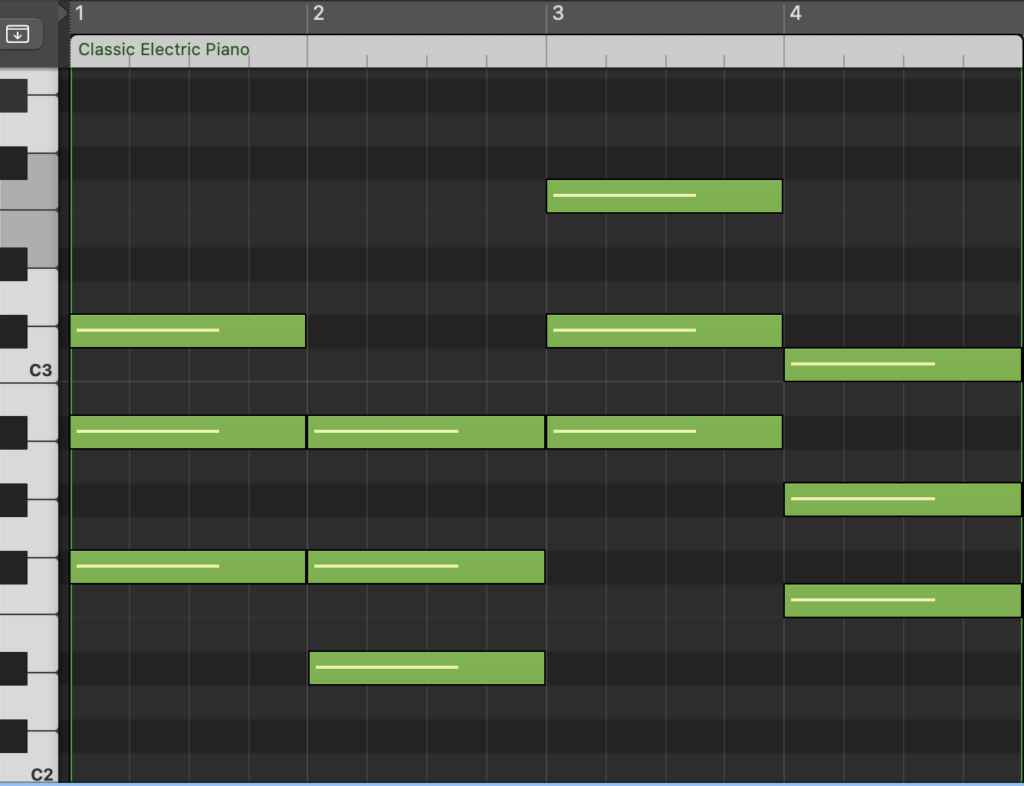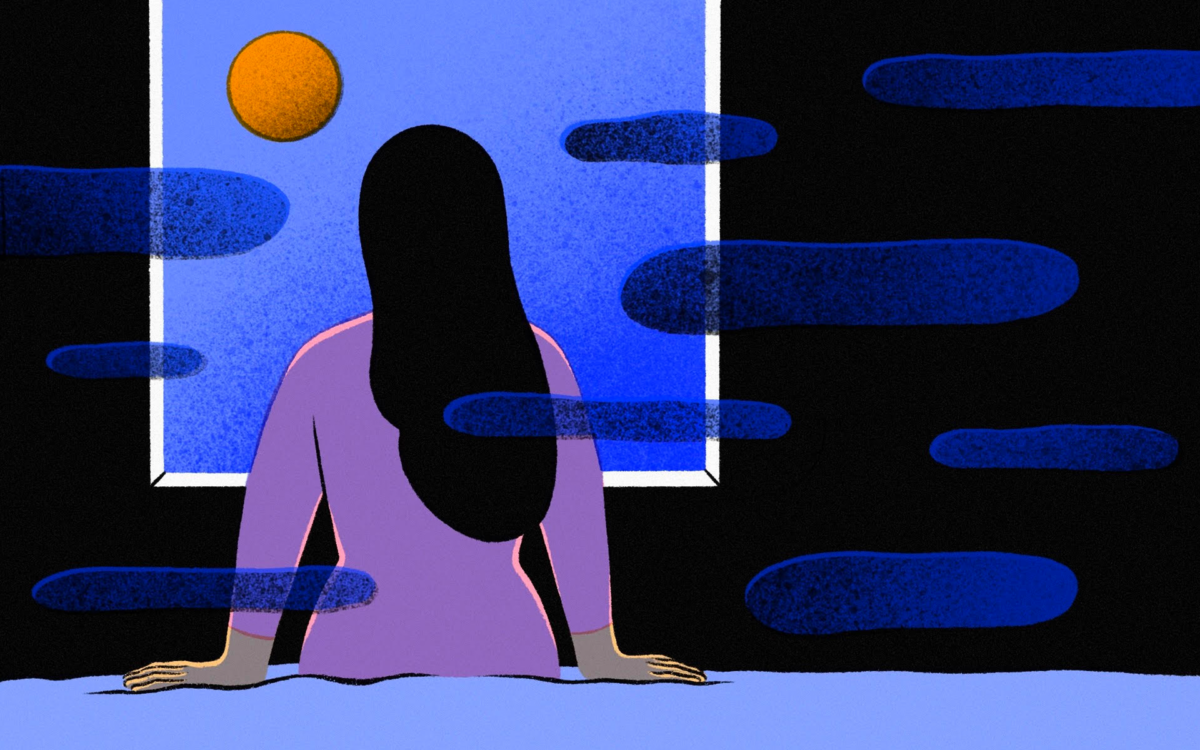Illustration: Nhung Lê
Writing sad chord progressions isn’t as simple as stringing together all of the minor chords in a key.
Rather, it’s a delicate art that involves balancing a wide array of compositional and contextual factors. In this article, we analyze 11 sad chord progressions and some songs they’re used in to identify what makes them so effective at tugging at our heartstrings.
Let’s dive in!
The music theory fundamentals of chord progressions
Before we dive into the specific chord progressions, it’s important that we have a shared understanding of some music theory fundamentals. Most notably, we’ll be using roman numerals (i, VI, VII, etc.) to express the individual chords in each progression.
The roman numerals represent the scale degree that each chord is built off of in any given key, with the casing corresponding to whether the chord’s quality is major or minor. For example, in the key of A minor, the ‘i’ chord is an A minor chord (the triad built off of the first scale degree), the ‘iv’ chord is a D minor chord (the triad built off of the fourth scale degree), and the ‘VI’ chord is an F major chord (the triad built off of the sixth scale degree).
Roman numerals are a valuable tool when discussing chord progressions because they help us identify and develop relationships with broad patterns without tethering them to a particular key. In turn, this also allows us to more easily translate chords to any key of our choosing when writing our own music.
If you’re looking for a more in-depth introduction to foundational topics like scale degrees, chords, and triads, check out our detailed guide below:
Access the world’s best sample library and connected creator tools for only $0.99.
11 sad chord progressions (with examples)
Without further ado, let’s get into analyzing some sad chord progressions. Each progression below is expressed via a piano roll image and an audio example that are in the key of the track it’s paired with. For consistency, we’ve kept all of the chords in root position (a voicing where the root note that the chord is built off of is the bass note) and as simple triads occupying one bar each at a consistent BPM. That said, note that there might be some flourishes in the piece of music they’re featured in (many of which we’ll discuss).
1. i – III – VII – VI

The i – III – VII – VI chord progression can be heard in the iconic verses of Adele’s “Hello.”
This progression is characterized by its ending on a VI chord prior to going back to the i chord, which creates a bit of an incomplete feeling. In “Hello,” this effectively synergies with the theme of the lyrics, which depict a heart-tugging phone call full of both hesitation and resolve. The block chord voicing in a lower register on the piano is also key in establishing a sense of heavy sadness.
2. i – VI – VII – v

The i – VI – VII – v chord progression can be heard in the chorus of Evanescence’s timeless “My Immortal.”
“My Immortal” adds drama and devastation to the i – VI – VII – v chord progression with its arrangement—the swelling strings and piano accompaniment come together to voice the pitches within each chord across a very wide register. Like “Hello,” a bit of syncopation is also utilized that helps add movement to the progression.
3. i – VI – III – VII

The i – VI – III – VII chord progression can be heard in the intro and verses of “Name of Love,” an ending song from the hit anime Attack On Titan.
While this chord progression is used incredibly broadly, “Name of Love” adds a feeling of grandness to it by also employing a suspended 4-3 motion over the VII chord. The delicate but unwavering arpeggiated line in the right hand of the piano arrangement also contributes to a tragic but gentle quality that makes the progression (and the song at large) such a perfect fit in respect to its placement in the show.
4. i – VII – VI – VII

The i – VII – VI – VII chord progression can be heard in the chorus of Goyte and Kimbra’s “Somebody That I Used to Know.”
This chord progression is characterized by its step-wise descending motion, which turns around with the second VII chord that smoothly ties back to the i chord. The guitar in “Somebody That I Used To Know” draws attention to this distinctive motion by voicing the root note prominently on the downbeats of each bar. While the song’s arrangement isn’t as dramatic as something like “Hello” or “My Immortal,” the sparse instrumentation is used intentionally to instill a feeling of emptiness and highlight Gotye and Kimbra’s mesmerizing vocals.
5. VI – VII – i – i

Chord progressions don’t always need to start with the i chord—let’s examine a couple examples that begin with the VI chord, starting with the VI – VII – i – i progression that’s heard throughout Billie Eilish’s haunting “ocean eyes.”
In direct contrast to the i – VII – VI – VII chord progression of “Somebody That I Used To Know,” the VI – VII – i – i chord progression features a clear ascending motion. Billie Eilish uses this chord progression to great effect in “ocean eyes,” juxtaposing the ascending chords with a descending vocal texture. Some subtle suspended notes bring additional emotional nuances, and every fourth repetition is varied by the introduction of a III chord that creates a sense of resolution.
6. VI – VII – v – i

The VI – VII – v – i chord progression can be heard in the chorus of Ikimonogakari’s “SAKURA.”
Also known as the Royal Road Progression, the VI – VII – v – i progression (or IV – V – iii – vi if interpreted in its relative major key) is an absolute staple in J-pop and J-rock music in particular. The distinctive VII – v / V – iii motion delays the resolution of the progression, which goes well with the feeling of going on a winding emotional journey. In “SAKURA,” the IV chord is also voiced with a major seventh, which is a common move that adds even more melancholy undertones to the music.
7. VI – VII – i – v

The VI – VII – i – v chord progression can be heard all over Charlie Puth and Selena Gomez’ “We Don’t Talk Anymore.”
The v chord feels like the most distinctive chord in this progression. In this instance, the chord could be substituted by a VII chord, and fills a similar role to it—it shares two notes in common, which smoothly resolve to pitches in both the i chord as well as the VI chord. However, the minor chord quality gives it that extra sad flavor that perfectly supports the themes of a song like Charlie Puth and Selena Gomez’ “We Don’t Talk Anymore.”
8. VI – VII – III – VI

The VI – VII – III – VI chord progression can be heard in the chorus of Sia’s powerful “Chandelier.”
There’s no rule that says a chord can’t be repeated consecutively in a progression, and in “Chandelier,” the still harmonic motion between the two VI chords in the VI – VII – III – VI progression is beautifully paired against Sia’s soaring vocals to establish an excruciating dramatic quality.
While our piano roll examples are in root position, “Chandelier” also notably voices the III chord in first inversion, or with the third as the bass note, which gives it some qualities that are reminiscent to the v chord in something like the Royal Road Progression.
9. VI – iv – i – v

The VI – iv – i – v chord progression can be heard in the chorus of Paramore’s “Decode.”
This progression stands out from the others in its use of the iv chord. Similar to how the v chord can often serve as an alternate option to a VII chord, the iv chord is kind of like a somber sibling to the VI chord, sharing two pitches and a predominant function in common. In “Decode,” Paramore use this chord to create meaningful motion from the preceding VI chord, while also infusing the track with a uniquely dark atmosphere.
10. I – iii – IV – IV

Sadness isn’t a quality that’s exclusive to chord progressions in minor keys; for our final two examples, let’s take a look at some major key examples, starting with the I – iii – IV – IV chord progression heard in the chorus of Billie Eilish’s “What Was I Made For.”
The stirring vocal performance, introspective lyrics, and delicate piano performance all come together to create an unmistakably lonely, heartbreaking effect. Yet, the major quality maintains a hint of hope, which beautifully captures the co-existence of the ideas of “I don’t know how to feel” and “But someday I might.” Like in “SAKURA,” the IV chord here is also complicated by a major seventh, which adds to the unresolved feeling.
11. I – V – IV – I

Last but not least, let’s take a look at the I – V – IV – I chord progression, which kickstarts the verses of Mayday Parade’s pop punk anthem, “Oh Well, Oh Well.”
A total departure from some of our other examples, this chord progression is about as major and bright-sounding as a chord progression can be—and indeed, the I – V – IV – I progression is also used in many other songs that we would readily classify as totally ‘happy’ songs. So what makes it feel so sad here?
The juxtaposition with the lyrics and vocal delivery is everything—as the narrative unfolds, we begin to realize that we’re reflecting back on a story of irreversible tragedy, but we’re trying our best to fight through the heartache and look at things positively (hence the major harmonic language and the title, “Oh Well, Oh Well”).
What makes a chord progression feel sad?
So, what makes sad chord progressions feel so sad? As we saw from our examples, the reality is that the answer lies in the sum of all of the context surrounding them—everything from the accompanying melodies to lyrics, instrumentation, tempo, rhythm, dynamics, sound design, production, and much, much more. While the 11 progressions we examined each have effective examples and some compositional qualities that can help us identify why we might associate a sense of sadness with them, if placed in different contexts, they could also absolutely feel hopeful, empowering, or optimistic.
This might not be the clear, one-case-fits-all answer we might’ve been looking for, but this nuance and depth is what ultimately makes music creation so fascinating and rewarding as a lifelong pursuit.
Download the MIDI for these sad chord progressions
If you’re looking to develop your own contexts for any of the chord progressions above, you can download all of the MIDI files for absolutely free here. Feel free to also use the chord progression samples below as starting points for your next track.
And there you have it! We hope this article gave you some ideas around sad chord progressions that can spark your creativity the next time you’re making music. Do you have any questions on any of the topics we covered? What would you like to see us discuss next? Start a conversation with us and an engaged community of other music creators via the Splice Discord.
Explore sad chord progressions that you can incorporate into your own productions:
April 9, 2024

.svg)
.svg)




